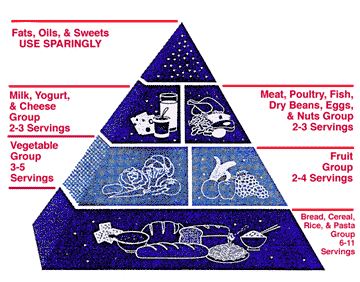
Diet for kidney disease |
Definition
A diet used in the treatment of renal (kidney) disease.
It may be low-sodium(Sodium
chloride is simply salt),
low-potassium(for a list of foods high in potassium click
here)and
protein(e.g eggs and chicken)and fluid restricted.
Alternative names
renal disease - diet; kidney disease - diet
Food Sources
This diet controls the amount of fluid, protein, sodium,
and potassium. The controlled amounts of each of these
nutrients are based on the person's blood levels of
potassium, sodium, and urea, as well as the fluid
balance, creatinine clearance, and blood pressure. If the
blood levels indicate the need to adjust the intake of
calcium and phosphorus, then the amounts allowed in the
diet are changed.
Functions
The purpose of a diet that restricts protein, sodium, and
potassium is to help the body decrease the waste products
produced by metabolism, which are toxic if they are not
eliminated from the body. This occurs from certain types
of liver and kidney diseases.
Recommendations
a)The amount of protein allowed in the diet is determined
by checking the amount of protein (and protein metabolic
wastes) in the person's blood. Laboratory tests may
include chem-20, creatinine, albumin, and blood urea
nitrogen. Low-protein diets may prevent or slow the
progress of some kinds of kidney disease. The amount of
protein the person can eat is based on how well the
kidneys are functioning and the amount of protein needed
to maintain good health. Dialysis and the type of
dialysis also influence protein needs.
b)The sodium content of a person's daily intake is
controlled. This helps in maintaining fluid balance in
the body to avoid dehydration or fluid retention. Reduced
amounts of sodium in the diet helps control high blood
pressure and congestive heart failure.
c)The daily intake of potassium is also controlled. This
helps prevent hypokalemia (a low level of potassium,
rarely a problem for people with renal disease) as well
as hyperkalemia (a high level of potassium, a common
problem for people with renal disease).
d)The mineral phosphorus is often controlled in this
particular diet. When the amount of phosphorus is
decreased by the reduced intake of dairy products and
other foods high in phosphorus, there is a need to
provide calcium supplements to prevent bone disease. The
amount of phosphorus in the diet is controlled by the use
of phosphorus binders (medications that bind the
phosphorus in the food and make them unavailable to the
body).
e)During renal failure, the amount of urine the body
produces is decreased. The recommended daily amount of
fluid is based on the amount of urine produced in a 24-hour
period. Other considerations are the amount of fluid
retention present, the level of dietary sodium, the use
of diuretics, and the presence or absence of congestive
heart failure.
f)People with renal disease are more prone to
cardiovascular (heart) disease, so a diet with most of
the calories from complex carbohydrates is recommended.
Calories from fats should be from monounsaturated and
polyunsaturated fats. The daily calorie intake needs to
be adequate to maintain the person's nutritional status
at an optimal level and to prevent the breakdown of body
tissue. The person's weight and protein status should be
monitored regularly, even daily.
g)Vitamin supplementation is very individualized. It is
dependent on the various dietary restrictions, the extent
of renal failure, and dialysis. The requirements for the
fat-soluble vitamins (A, D, E, and K) are usually met by
the diet. Vitamin D may need to be supplemented; this is
an individual medical decision. The intake of water-soluble
vitamins is often inadequate, as several good food
sources of water-soluble vitamins are restricted on this
diet. There is also loss of water-soluble vitamins from
dialysis, the cooking methods for leaching potassium, and
altered metabolism of vitamins.
h)The minerals that are also monitored include calcium,
iron and magnesium. The recommended supplementation of
daily calcium is 1,000 to 1,500 milligrams per day. Iron
supplementation is based on the person's need. Magnesium
supplementation is not recommended, as it can cause an
increase in the magnesium levels in a person with renal
disease.
"When
I was first transplanted every kind of food
containing a small amount of salt was strictly
forbidden for consumption.But now after my second
transplantation,I'm actually encouraged by my
Doctor to eat very salted food.?Go figure?
|
Side Effects
A low-protein diet can be deficient in some of the
essential amino acids; the vitamins niacin, thiamine, and
riboflavin; and the minerals phosphorus, calcium, and
iron.
Benefits of implementation:
It is helpful for a long-term feeling of well-being to
adhere to the diet as closely as possible. Nonadherence
can aggravate the symptoms of renal disease and interfere
with recovery.
Notes:
The Kidney Foundation has chapters in most states and is
an excellent resource for educational and materials,
programs for people with renal disease and their families.
Registered dietitians are also a resource for nutrition
information specific to kidney disease; some are
specialists in renal diets.
A Guide to Daily Food Choices (applicable for non-renal patients and must eventually be adapted for Kidney patients)(click on the image to access the original page this graphic comes from)
FOOD GROUP |
SERVING SIZE |
Bread, Cereal, Rice & Pasta |
1 slice bread |
Vegetables |
1 cup raw leafy
vegetables (lettuce, spinach) |
Fruit |
1 medium fruit (banana,
apple, etc.) |
Milk, Yogurt & Cheese |
1 cup milk |
Meat, Poultry, Fish, |
2-3 ounces cooked lean
meat, fish, |
| Count as 1 ounce
meat equivalent: 1 egg or 1/4 cup fat-free egg alternative 1/3 cup nut, 1/2 cup cooked dry beans 1 tablespoon peanut butter |
IMPORTANT DISCLAIMER!! The original text may have been slightly modified Copyright © 2001 Yahoo! Inc. All Rights Reserved. |